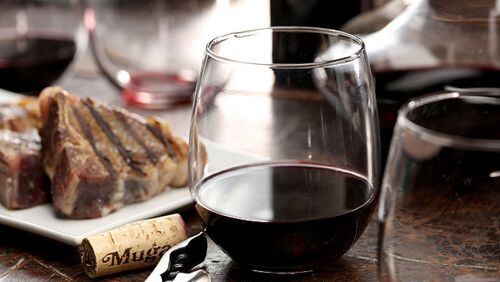This is one of those big-fish-in-a-big-pond situations.
The pond is Spain, the place with more vineyard acreage than any other country on earth, and the fish is tempranillo, Spain’s big red grape variety. It’s actually not Spain’s most widely planted wine grape; that honor belongs to the white grape variety airen. But as anglers and wine buffs know, big ponds often have more than one kind of big fish, and all big fishes are not equally rewarding to catch.
Tempranillo is the trophy catch of Spain. The word itself is derived from “temprano,” which is Spanish for “early,” and it is believed that the grape got its name because it tends to ripen on the early side of the harvest season. Despite its widespread presence on the Iberian peninsula — or perhaps because of it — tempranillo also goes by many other names in its home country.
In the storied region of Rioja, where the grape has gathered most of its acclaim through the decades, it is called tempranillo. But that is where the clarity ends. In nearby Ribera del Duero, a region that has been gaining ground on Rioja in both quality and reputation for years, the grape is called tinta del pais or tinto fino. In Toro, it is called tinta de toro. In Penedes, it is called ull de llebre in the local Catalan language (and ojo de liebre in Castilian, i.e., good ol’ espanol), and in Valdepenas and La Mancha, it is known as cencibel. Of course, none of this is sensible to the outsider, since all of it is tempranillo. (And there are many other aliases too.)
It is easy to understand why another country would have an alternate name for it (that whole “different language” thing), and even Spain’s neighbor to the west, Portugal, has two separate names for it: tinta roriz and aragonez. It’s almost as if the people who know what a great grape variety tempranillo is have been trying to distract and confuse everyone else, just to keep their secret safe.
But alas (or thank goodness, depending on which side you’re on), the word got out, and a study by the University of Adelaide (South Australia) concluded that, as of 2010, tempranillo was the world’s fourth-most-planted wine grape behind cabernet sauvignon, merlot and the aforementioned airen. Tempranillo also landed in front of such popular grapes as chardonnay, sauvignon blanc and pinot noir.
Despite not being formally knighted a so-called “international variety” (a well-known grape recognized for its ability to produce top-quality wines around the world), tempranillo continues to grow in popularity, and it would not be much of a surprise if one day it were to pass up its white Spanish counterpart airen on the world’s-most-widely-planted list.
When it comes to turning the grape into wine, tempranillo usually does not go it alone. Though it provides a base for many wines, it is not a grape variety that stands up for itself and shouts out its most redeeming qualities over a bullhorn. Instead it moves with the crowd and relies on help from others — notably garnacha (grenache) and mazuelo (aka carinena/carignan) in Rioja, and cabernet sauvignon, merlot and other grapes elsewhere in Spain. Strawberry is a common descriptor of tempranillo, and from there, aromas and flavors can move on to cherries, black fruits, herbs, tobacco, leather and spice. Tempranillo produces medium- to full-bodied wines, especially when blended with heartier grape varieties, and can range in color from ruby red to deep crimson.
This is a wine style that pairs well with ham, lamb, grilled meats, casseroles and game. You could also settle in with a friend and a bottle, along with a hunk of Manchego cheese and some crusty bread. Another option would be to light a candle, pour yourself a glass and crack the binding on “Don Quixote” or “The Sun Also Rises,” dreaming of running with the bulls. Tempranillo surely makes up the majority of red wines swilled at festivals across Spain, so go ahead and drink it out of a bota bag if you like, but if you are a beginner, may I suggest not wearing a white shirt. Or if you must wear white, at least tie a red handkerchief around your neck. I’m speaking from experience here.
Tempranillo is especially fond of oak barrel aging, and the practice has been a hallmark of the country’s two most famous tempranillo regions — Rioja and Ribera del Duero. But it is not the rule. Despite the fact that tempranillo can be extremely age-able, it is possible today to find young, fruity unoaked versions of it in both regions.
California, Oregon and Washington turn out tempranillos, as do Argentina (where it usually takes the feminine moniker “tempranilla”) and Australia, where it is often blended with grenache and the Aussie superstar shiraz. In Portugal, tempranillo (as aragonez or tinta roriz) is used in table wines and ports. Even Italy has some tempranillo, and of course they have their own name for it: malvasia nera. While we’re at it, California has had an alternate name for tempranillo, too: valdepenas (yes, just like the Spanish wine region Valdepenas, where tempranillo is referred to as cencibel).
Obviously Spain, particularly Rioja, is the place where this grape variety enjoys its most-esteemed reputation. The legendary Muga and Marques de Riscal wines come from Rioja, but it is Ribera del Duero that is home to what is possibly the most famous and revered Spanish wine of all, Vega-Sicilia. Ribera del Duero’s combination of blazing daytime heat and high-plateau nighttime cool create the perfect growing conditions for tempranillo, although its global sprawl suggests quite clearly that it does just fine elsewhere too.
About the Author






